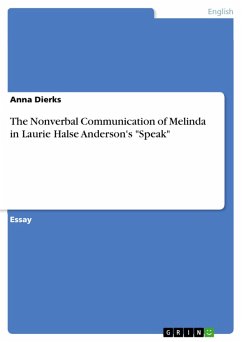Essay from the year 2017 in the subject English Language and Literature Studies - Literature, grade: 1,3, University of Paderborn (Institut für Anglistik und Amerikanistik), course: Essay Writing, language: English, abstract: One cannot not communicate. Of course, communication does require words that are spoken, but there is more to it than that, such as intonation, the speed of your language, breaks, laughter, sighs, your appearance and your body language. According to Paul Watzlawick, any kind of behavior belongs in the category of communication. Since it is not possible to not behave, it is also impossible to not communicate, even without words. Needless to say, the spoken word is what most conversations depend on and which represents a major part of communication. However, language is not innocent and has often been used by many people to manipulate or offend someone else. People with a low self-esteem often appear quiet and hardly share their actual opinion. They fear the negative consequences that could occur after saying something critical. Also, they neither believe in themselves, nor that anyone cares about what they say. The issue of a low self-perception forms a major idea of Young Adult Fiction which is the genre that particularly addresses the youth as it copes with subject matters adolescents can relate to. The author of Speak, Laurie Halse Anderson, positions the main character Melinda very clearly towards communication in the beginning of the book with the following statement: "It is easier to not say anything. Shut your trap, button your lip, can it. All that crap you hear on TV about communication and expressing feelings is a lie. Nobody really wants to hear what you have to say." Not speaking even if you were able to means breaking up with the ability of communication and severing all your contacts. This is how the character Melinda completely isolates herself from her surroundings when she is not speaking which is a consequence to the trauma she suffers after being raped. Anderson makes Melinda avoid most trouble and public embarrassments and puts her into a state of shock. Although Melinda's inner voice often appears very sarcastic and humorous, she hardly speaks to other people around her. Still, the reader is a witness to the events in Melinda's everyday high school life and learns a lot about her life only from the images that Anderson is describing in each chapter. Through a reference structure, the author makes sure that the reader constantly perceives Melinda's wellbeing on different levels when she creates images and atmosphere rather than telling the actual meaning of certain subjects.
Dieser Download kann aus rechtlichen Gründen nur mit Rechnungsadresse in A, B, BG, CY, CZ, D, DK, EW, E, FIN, F, GR, HR, H, IRL, I, LT, L, LR, M, NL, PL, P, R, S, SLO, SK ausgeliefert werden.









